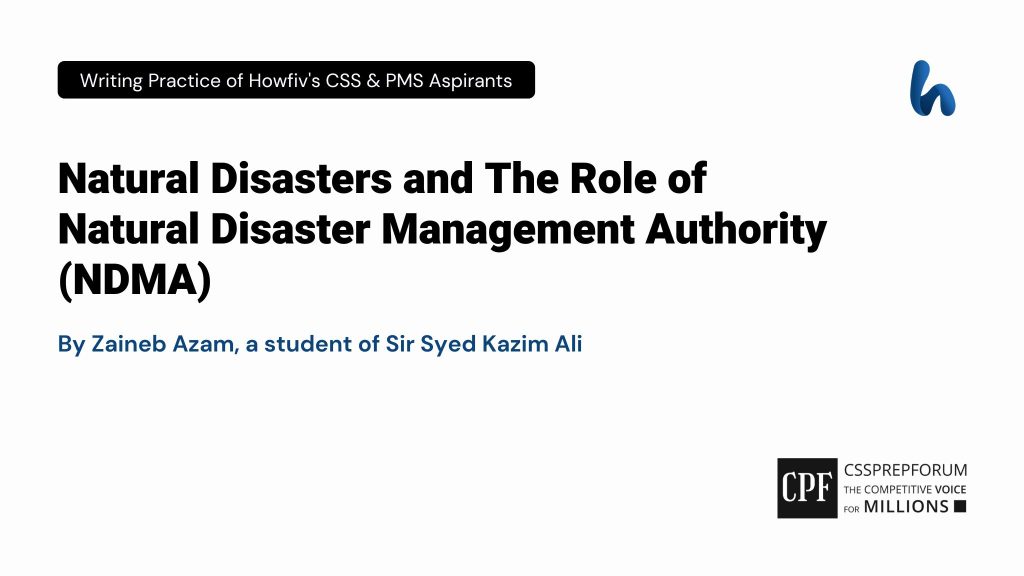Disaster Management in Pakistan | Natural Disasters and The Role of Natural Disaster Management Authority (NDMA) | Best for CSS, PMS Essay
Table of content:
- Introduction
- What are disasters and their different types?
- What are disaster management and the process of disaster management?
- Disaster Management in Pakistan
- Effects of poor response management of disaster
- Causes of weak disaster management in the country
- Recommendations
- Conclusion

Introduction
The geographical history of the world has witnessed many disasters since its inception. Disasters are wreaking havoc on the entire world. It has threatened the peace of the globe and gobbling up the very existence of the world. Whereas, there are different types of disasters, mainly natural and man-made. Moreover, natural disasters are unavoidable. These may take the form of floods, earthquakes, volcanoes, drought, pandemics, etc. However, with the advancement in research and technology, some methods have been developed to reduce the severity of the damage caused by these catastrophes. Furthermore, disaster management is the only possible way forward in this regard. Today, no country is immune from these disasters. It is affecting developed and developing countries alike. However, some states are considered more vulnerable to natural calamities due to specific features, e.g. weather patterns, location, and attitude. Due to its geographical position, Pakistan is considered among the list of countries at higher risk of catastrophe. The government is expensing disasters in the form of floods and earthquakes. Unfortunately, floods are an almost annual event in this country. The country has lost thousands of precious lives and billions of rupees at the hands of disasters. These kinds of disasters let the country realize how poorly equipped and empty-handed she was. Therefore, the impacts of the lack of disaster management are far-reaching and diabolic. Annuls of disasters history in the country shows the clear picture to make it clear that the country constantly remained in danger of facing disasters. Moreover, it is necessary to devise a strategy to cope with such disasters. Keeping this in view, the National Disaster Management Authority (NDMA) tries to minimize the harm and restore people to a normal state. Additionally, the successive government kept this fact in mind and tried to counter this menace. Here, the light will be thrown on explaining disasters, their types, disaster management, and its process—furthermore, the disaster situation in Pakistan, its impacts, causes, and the way forward.

What are disasters and their types?
(Vulnerability + Hazard) / Capacity = Disaster
A disaster is a sudden, calamitous event. It can also be defined as, “A catastrophe, or a calamity in an affected area, arising from a natural and or manmade cause, or by accident which results in a substantial loss of life or human suffering, and destruction of property.” Moreover, The United Nations defines a disaster as “A serious disruption of the functioning of a community or a society involving widespread human, material, economic or environmental losses and impacts, which exceeds the ability of the affected community to cope using its own resources.”
Here, it can be said that:
- Disaster means a catastrophe, or calamity affected area or a serious disruption
- Its causes are both natural and man-made
- Its impacts are catastrophic; such as human losses, economic, environmental, property damage and psychological

Types of Disasters:
There are four main types of disaster;
- Natural disasters Geophysical
- Earthquakes
- Landslides
- Tsunamis
- Volcanic Activity
- Hydrological
- Avalanches
- Floods
- Climatologically
- Extreme Temperatures
- Drought and Wildfires
- Meteorological
- Cyclones
- Storms
- Wave Surges
- Biological
- Disease Epidemics
- Insect / Animal Plagues
- Man-Made Disasters
- Environmental Degradation
- Pollution
- Accidents
- Complex Emergencies
- Food Insecurity
- Epidemics
- Armed Conflicts
- Displaced Population
- Loss of Life
- Widespread Damage to both Societies and Economies
- Pandemic Emergencies
- COVID-19
- Dengue Fever
- Yellow Fever
- Malaria
- Ebola
- Zika

What are disaster management and the process of disaster management?
Disaster management starts with strategic and organizational management, which aims to protect vital assets from hazard risks in any emergency. Furthermore, it means managing the complete disaster, avoiding injuries, and saving lives. Moreover, the process of disaster management includes;
- Mitigation:
The whole process starts with mitigation. It eliminates and reduces the probability of disaster occurrence. It may also reduce the effects of unavoidable disasters. Furthermore, mitigation measures include building codes, vulnerability analyses, safety codes, preventive healthcare, and public education.
- Preparedness
Preparedness is nothing but a satisfactory level of readiness to respond to any emergency, with the help of programs that strengthen the technical and managerial capacity of communities, organizations, and governments. It includes logistical readiness and developing long and short term strategies, ensuring public education and awareness. It also ensures the reserves of food, water, medicine, and equipment to respond quickly in case of an emergency.
- Response
The third step of the disaster management process is quick response. It provides immediate assistance to maintain life, improve health, and support the morale of the affected population. Therefore, the immediate concern of the response phase is to meet the basic needs of the people until a sustainable and permanent solution can be found.
- Recovery
The process of recovery begins after the emergency is brought under control. A recovery activity includes providing the affected populace with temporary housing, health facilities, and education in a broader context. This activity continues until the circumstances return to normality.
- Reconstruction
It includes repairing the damages to public and private properties, infrastructure and undoing all the disaster effects. Therefore, it is the last phase of the disaster management process; it can be taken as the first step. Moreover, all the necessary preparatory measures are adopted to provide safety against any future disasters.

Disaster Management in Pakistan:
Floods are almost annual events in the country. However, this is not a matter of concern every year, but when the normal flooding level is exceeded, it results in colossal damage, e.g. floods in 2010 and 2014 caused serious harm to people of the country. In the same way, the earthquake in 2005 and the recent drought in Thar claimed many lives. In the contemporary world, the Novel Coronavirus has claimed many lives. But, it is quite perturbing that no lesson has been learnt from history, especially in the context of floods. It’s not wrong to say that the annual monsoon is a natural phenomenon, but the flooding they cause is entirely preventable. Furthermore, the country has been hit hard by almost 21 major floods since its inception. All of these massive floods caused severe human, financial, and infrastructure losses in the country.
Effects of poor response management of disaster:
Unfortunately, Pakistan faced many problems, as discussed above, because of natural disasters. Here, some of the major impacts will be highlighted due to weaker disaster management. To begin with, basically, the actual disaster results in the second disaster. Moreover, it sends another wave of damage to people away from the original one. Like, the tsunami had caused a human loss, infrastructure loss etc. which is a direct impact. Furthermore, it also leads to the disturbance in the trade of fishing industries, which has directly resulted in lower wages and an increase in unemployment, especially for those associated with the fishing business. Therefore, it is surprising that sometimes, the second disaster proves more devastating than the actual one just because of its indirect repercussions.

Moreover, another adverse impact of this disaster is the severe setback to the economy of the country. Natural disasters like floods and earthquakes cost huge losses to the infrastructure and buildings. The cost for the repair of these infrastructures acts as an extra burden on the national exchequer. In the same fashion, the rehabilitation of the dispersed makes the issue more serious. Notwithstanding, the textile industry, which is considered the largest manufacturing industry in the country, is directly affected because of the losses caused by a disaster.
In addition to these, the outbreak of the virus, such as COVID-19 and more diseases, further aggravates the situation. Many people have to suffer from fatal diseases, mainly because of the non-availability of clean drinking water, e.g. gastroenteritis, diarrhoea, and many more. Additionally, the eruption of cholera, skin diseases and asthmatic attacks are top of the list of these catastrophes. Therefore, all these diseases have serious impacts on human health.
Furthermore, the food crisis cannot be neglected in this regard. Millions of acres of agriculture may submerge underwater because of the flood as some crops are temperature sensitive and require some specific temperature for their cultivation and proper growth. Such crops are planted and cultivated at a particular time. If this timing is disturbed because of a disaster, a country has to face scarcity of food.
Lastly, psychological damage to the people is also a serious impact of this menace. As many people have to leave their homes in case of a disaster. Furthermore, their socio-economic fabric has also been disturbed along with health and education. These are some of the basic reasons that they face a sense of deprivation. Over and above, these jobless, socially and morally deprived youngsters of affected areas are easy prey to militant recruitment and criminal activities.
Causes of weak disaster management in the country:
After discussing some of the impacts of this menace, it is important to discuss the main causes of the disasters and their management. Here, some light will also be thrown on those factors which played their part in the inefficient role of its management apparatus. Above all, the negligence of the government is mainly responsible for this situation. The budget which is allocated for the NDMA is insufficient to fulfil its needs, as the country has to experience frequent floods due to climatic and ecological conditions. The other main responsibility of the government is to recognize the major vulnerable areas according to the geographical location, which the government is not following standards. Unfortunately, the government never made these issues a priority. That’s why there is a lack of accountability and decision making because of the less vigilant role of the government towards disasters.
Importantly, the construction of small and big dams is the need of the hour to counter this menace. But the government does not seem to be much serious about it. Lack of political will and political instability is the root cause owing to this. The Sindh River is the biggest in water flow, but its water never generates floods because of the “Terbela dam”. Kalabagh Dam is a live example of political instability. If the dam has been constructed on time, the country could save the lives of the people and other impacts of this menace.
In addition to these, global warming is another main factor of floods and an uneven pattern of rains in the country. It is a fact that glaciers are being melted due to the increase in temperature of the globe, which results in heavy floods. Furthermore, Pakistan is situated in the Monsoon region that is the major reason for rainfall in summer. Likewise, industrial production and wildfire cannot be neglected in this context.
Despite the fact that all these causes have wreaked havoc in the country, apart from this, National Disaster Management Authority (NDMA) is also responsible for the massive damage caused by the floods. Notwithstanding, flood is a slow onset disaster, it provides enough time to authorities to take precautionary measures in this regard. Therefore, the severity of the harm caused by the 2014 flood could be lessened, but due to lack of technical management and proper planning, the whole country had to bear the brunt of floods and heavy damages to life and property.
Recommendations:
It is true that disasters are natural, but the destruction caused by calamities can be mitigated as every problem has a solution. Here, some practicable measures will be brought under discussion, which may prove helpful to manage disasters more effectively and quickly. To begin with, the responsibility lies on the shoulder of the government. Therefore, more sums of the budget should be allocated for disaster management. In the same way, it should abridge the policy performance gap, such as the implication of the policies must be made certain.
Similarly, it must also devise a plan to build new dams and do away with all the hurdles in its way.
In the same fashion, risk assessment is a significant factor in decreasing the instance of a disaster. Moreover, quantitative and qualitative understanding of geographical location and probability of hazard in very crucial in this regard. That can be done by involving governmental and technical working groups and including scientists so that their mutual effort can provide an error-free assessment of the most vulnerable region.
Most importantly, media can also play a vital role in making the masses aware of the advantages of dams. Presently, it can highlight the benefits of the Kalabagh dam, which is a matter of serious concern since its inception. As media is considered a fourth pillar of the state, it can also play a major role in the check and balance system of the government—specifically, the performance of the government with respect to the planning and management for the disaster.
Likewise, Disaster Risk Reduction (DRR) education is also much important for reducing potential hazards. Furthermore, capacity building at a community level can help in creating awareness about DRR. Moreover, active participation of community-level and civil society can prove much effective in this regard. Anyhow, it can also be done by introducing DRR into the curriculum of educational institutions, such as engineering, architecture, environmental and social science and many more.
Conclusion:
As it is rightly said that a stitch in time saves nine, in the same way, timely and proper disaster management is a blessing for a country. It is a matter that climate change is casting its evil eyes on the whole world. No country is immune from natural disasters. Pakistan is one of the worst-hit countries owing to natural disasters because of its geographical location. Therefore, it is important to carry out comprehensive research on risk factors to save people from socio, economic, and moral fabric. However, if proper measures are not taken in this regard, the nation’s future can be darker. Moreover, all tiers of disaster management authorities play a leading role in mitigating the devastating effects of this menace. But there is still enough to be done in this regard. Losing hope is not a solution to any problem. It is the need of the hour to understand the importance of implementation of disaster risk reduction policy in letter and spirit. The factors mentioned above for mitigating the devastating impacts of this menace can help create and utilise the knowledge in the best possible manner. Therefore, serious efforts by the concerned austerities can nip this evil in the bud.
About the Author
Zaineb Azam is a government officer. She has been one of those CSS aspirants who scored the highest (78 marks) in Pakistan affairs. Moreover, she has been a known content writing coach in Pakistan, especially for females. She teaches girls how to start blogging, content writing, and copywriting and helps her become an online content creator to start earning online. Besides, She has been providing guidance to CSS and PMS aspirants about the preparation strategies.
Are you looking to learn English communication skills to qualify for the CSS and PMS English essay & Precis papers? Let’s join Sir Syed Kazim Ali and learn how to give your ideas and thoughts words, fluently and confidently.
CSS & PMS 2024 Extensive English Course

Articles Might Interest You!
Available Online Courses
- CSS English Essay and Precis Course
- CSS 5-Month English and Compulsory Course
- PMS English Essay and Precis Course
- CSS English Essay and Precis Crash Course
- Basic English Grammar and Writing Course













